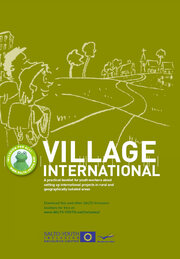Setting up a rural youth project? – Project management
There are many ways to manage a project. Some will definitely lead to a successful project, some may not, and some may, but with some detours.
For every successful project you need to look at four different factors:
1. Start from a need or problem
Projects work best when the people developing them know and understand the needs and problems they want to tackle. It is important to properly evaluate the need or problem before starting any project.
- What causes this particular problem in our rural area?
- What are the symptoms?
- What is the scale of it?
- For whom is it a problem?
- Only for young people - or for the entire community?
2. See the opportunity for your project
Projects need to have, or to create, a space in which to operate. Projects need to be actively supported and backed with more than just money. There must be support for the project from key people and active participation from the target group.
- Are your young people behind the project?
- Do they have sufficient time to deal with it?
- Which other actors need to be involved?
- How will they support you/your project?
3. Create a vision
Projects need a vision to frame all the activities and efforts. It is from the vision that strategies, objectives and work plans flow. The big idea behind the project should be clear enough to show how the project will make a significant and sustainable difference to the needs or the problems.
- Do all the rural young people involved in your project have the same vision?
- Are you working towards a common goal?
- Are you able to picture this vision together and be enthusiastic about it?
- (only then will you be able to transmit it to other people in your community and get other key actors on board easily)
4. Gather skills and resources
Projects need the right balance of skills, energy, resources and organisation to get going and deliver results. They need to be designed so that they are able to make an impact and create results.
- Do you have a capable and balanced team, with complementary skills and resources behind the project?
- If there are some specific skills missing, who are you going to consult to get the necessary skills/knowledge/know-how on board?
- Are the results, and the impact you are aiming for, clear to everyone? What is it for: you/your youth group/your community? Are your aims short or long term?
^^ top ^^
What? Who? When? Where? hoW? & Why?
One of the most common ways to develop your project is to plan it according to the 6 Ws (adapted Laswell model):
- What? Who? When? Where? hoW? & Why?
These are the questions that can help you in clarifying your project. They allow you to quickly check if you have thought of everything.
The first question, is the WHY? This question is linked to your analysis of the needs and problems that you want to address. The answers to this question are your aims and objectives:
- What is needed from or wished for by the young people concerned?
- Is it wanted by the community and the young people?
- Why should everybody be interested in it?
- What do you want to achieve?
- What should be the impact or result of the project if it is successful?
- How would the situation have changed?
- How much of a priority does it represent?
- Is your project trying to achieve something different from what is already being done?
Your aims and objectives (Why?) lead you to a decision on the WHAT? question. Depending on what you want to reach, there are different ways of getting there. The What? question refers to the type of project or activity you will be doing.
- What activity is most adapted to the people you are working with?
- What are your own preferences and previous experiences?
- What resources do you have available for the project?
- Do you have time or place constraints or opportunities?
The next question leads us to WHO? Who are you working with? Who has certain needs?
- In more detail: Who would you like to involve and reach with your project?
- What is the target group and who are the beneficiaries of your project?
- Who are your partners? What can they bring to the project?
- Who will co-ordinate the project?
- Are participants involved in running and co-ordinating the project? If so, how?
- What is the role of rural young people in the project?
The following step deals with: HOW? are we going about this? How are you going to put the project into practice?
- What resources are available to you (time, money, young people, authorities, etc.)?
- What do you need to do in order to make the project a success?
- What methods will you use to reach the aims?
- Describe your project's structure and activities. Why these activities?
- How will you steer the process? (clear division of tasks)
- What expertise do you need to look for externally (partners, funding...)? How are you going to get these?
The next question is WHERE? This question refers to the context and location in which you are going to carry out the project.
- Are you going to go abroad with your group?
- Are you hosting a group within your local community? Where are they going to stay?
- Where are you going to work / enjoy the programme together?
- Are there any place constraints? Or specific places you can or want to use?
- Is there any link to be made between the activity and the place?
And to make our project sun complete, you also need to think about the WHEN? question. Are there any issues concerning the timing of your project?
- What is the starting and closing date for the project? (a project has a beginning and an end)
- Don't let the project go on forever! Stop it when it fails to deliver any further benefits
- Did you agree on a time-line for your project? What are the different stages and deadlines? (e.g. applying for funds, contacting partners, meetings of young people, informing, booking a venue, etc.).
- Are there any periods to avoid (exam periods, election periods, high season,...)? Or are there any periods that would be particularly beneficial for your project?
- What comes after the completion of the activity? (e.g. accounts, thanking people, reports, evaluation, documentation, follow-up;)
Rural Tip
Don't underestimate the duration of your project, including all preparation, as well as follow-up at the end of the activity. Rather, overestimate the amount of time in your project- and activity plan! Most likely you will need it!
All 6 questions need to form a coherent picture. All parts of the project sun should be connected to the centre of the sun: the WHY? question. Be ready to give good reasons for choosing amongst alternatives.
E.g. why have you chosen to do a youth exchange rather than a youth initiative? Why do you want to involve both rural and urban young people in your project? Why are you involving the local authorities? Why would you do an exchange in winter rather than in summer? Etc...
For more about the project management of international youth activities, please refer to:
- SALTO Over the Rainbow booklet > www.SALTO-YOUTH.net/OverTheRainbow/
- SALTO Handbook on Project Management > www.salto-youth.net/find-a-tool/86.html
- T-Kit on Project-management > www.youth-partnership.net or www.salto-youth.net/find-a-tool/68.html
^^ top ^^
Get Active - Exercise
Aims & objectives
Think about the project you want to do: What vision do you have about the activity? Where do you want to get to at the end of it? What do you want to reach?
What are your aims and objectives?
- The aim is what you see if you take binoculars and look into the future, the final result, where you want to get to.
- The objectives are the smaller steps you need to take to get there
When defining those little steps, the objectives, make sure that they are 'SMART'. Formulate your objectives, in a way that they fit the SMART criteria:
- S - Specific > do they clarify precisely what they are about?
- M - Measurable > how will you know when they have been achieved?
- A - Achievable > are they within the control of you and your project team?
- R - Realistic > are they realistic and relevant within the frame of your project?
- T - Timed > have you agreed over what period they should be achieved?
Rural Tip
You will have a better chance of succeeding if you know what you are aiming at. You will be able to avoid doing unnecessary and unwanted work.
If your project fits in with other projects or other work within the organisation, you need to ensure that there is no overlap and no gaps.
^^ top ^^
Downloads
The following downloads are available:
- Village International - setting up international projects with rural youth - 2007
A step by step manual through the different stages of setting up a youth project in your rural or geographically isolated area. With lots of practical tips and tricks. Based on SALTO TC Rural 2007. (Rightclick & download to your PC)




